The Eight Master-Pieces of Corsica
By Johan Buchner

Statement of Purpose.
Usually cars look best when clothed by coachbuilders of the same nationality.
For the T57S that means Gangloff. For a Bentley, Gurney Nutting, a
Mercedes-Benz, Sindelfingen and for the Duesenberg Models J and SJ, Murphy or
Rollston. The only problem is that all five bodies created by Gangloff are
ravishingly beautiful, making it impossible to write anything but paeans of
praise. Which makes for boring writing, and reading.

By concentrating on the eight T57S bodies built by Corsica, I am hoping to
achieve two things; firstly I hope to instill in you my enormous admiration for
the flair of the coachbuilder, and, secondly, to celebrate the art of coach
building itself. And to spice matters up to a nicety, two of the bodies are,
well, crap. Two monstrosities, one of which, thank God, is no more, which came
about as a direct result of the willful eccentricities of the original owners,
serve as counterpoint to the beauty of the rest.
The histories of all eight are so well known, that I have been able to devote
most of my time and effort to a comprehensive celebration of this most
cosmopolitan of British coachbuilder’s work. Corsica bodied chassis’ from Alfa
Romeo, Bentley, Delage, Invicta, Mercedes-Benz and, of course, Bugatti of which
57593 represent the zenith, 57601, the nadir. Someone once remarked, whilst
talking about British Art: “My, how varied it is.” The same would seem to apply
to their coachbuilders. Loving the British is easy; admiring them, compulsory,
but liking them, on the other hand, requires just that little bit more effort.
Well worth it though.
The T57S, like most Bugattis, serve but one purpose; to be beautiful. A rather
arrogant statement wouldn’t you agree? I am unrepentant in my belief that the
beauty of the coachwork is much, much more important than function. Some of the
original owners, however, put function above form. Function more important than
beauty? On a Bugatti? How odd.
Corsica built two coupes, two 4-seater tourers and four open 2-seaters; they all
survive but one of the coupe bodies is no more. This is essentially an
appreciation of styling so allow me to group them according to the coachwork,
starting with the coupes.
Coupe Number One.
57601 Engine 42S
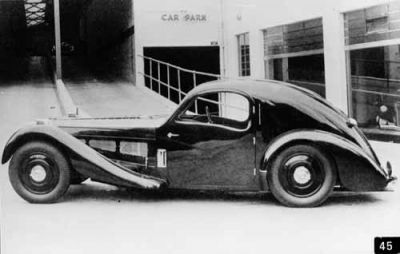
Chassis’ 57601 & 57602 are the two highest ch. no’s and both fitted with Coupe
bodies, 57601’s body being destroyed by fire. A fitting end to the ugliest
coachwork ever to be inflicted on the innocent eyes of aesthetes the world over.
Just look at this hunchback Atlantic’s grotesque visage; every line, every
curve, every view offends; none more so than the anemic front wings, made even
worse by comparison with the “full-figured” backside.
Let me stop bitching about the body for a moment and give you , dear reader, a
brief history of 57601. Fitted originally with engine no. 42 the chassis seems
to have been completed in 1936 but only sold in 1938. This is the second highest
chassis number, so I suspect 601 was only fitted shortly before being sold. This
might explain the low frame number of 15. The first owner was a Mr. Pearce-Jones
of Oxshott and he ordered the car in 1938 through the British Bugatti agent
situated on London’s Brixton Road, from where it was sent to Corsica to be
fitted with the body once described by famed Bugattiste (and subsequent owner)
Ronny Symondson as: “A fruitless attempt to copy the Atlantic” Quite. Registered
on the 7th of June 1938 with the registration number J 222, 57601’s history
until 1948 is unknown. The original owner’s life is also a bit of a mystery. He
was one of the first members of the B.O.C. but it is not known if he ever owned
any other Bugattis, or whether he kept the car until 1948 when it passed to
Donald Campbell who, in turn, only kept it for a short while before passing it
on to T.A.D Crook’s Crooks Motors Ltd. Garage in Caterham, Surrey.
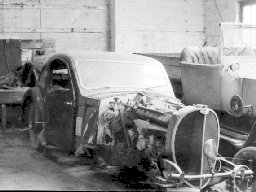
He sold the car in 1949 to Dennis Dwyer who in turn passed it on to Daniel
Richmond in 1952 who crashed it shortly afterwards. The remains were stored for
a future rebuild but in 1964 the hanger caught fire and 57601 was severely
damaged. The fire seems to have broken Mr. Richmond’s spirit and he gave the
remains to Ronnie Symondson. I find this so very sad, imagine being so broken up
about the loss of a car that one cannot even be bothered to try and sell it.
Grief stricken he just turned his back and walked away, but by giving the car to
Mr. Symondson he assured its survival, and for that we should all be grateful.
By the time Ronnie Symondson received the car it needed a lot of work and a
great many parts were so badly damaged, there was no choice but to replace a
whole slew of them. The engine block, cylinder head, crankcase, crankshaft,
ignition, right front half-axle, steering box, front brakes, rear shock
absorbers, gearbox casing and radiator were all replaced. The chassis was badly
bent and two of the cross members, including the important one between engine
and gearbox, needed replacing. Thankfully, little of the original body remained,
and the bits that did were rusted and the wooden frame was rotten.
A lot of credit must go to Mr. Symondson for respecting the wishes of Daniel
Richmond by restoring this severely damaged car instead, of using it as a spares
car for his other 57S, 57375. There are no questions about its originality; only
by replacing all the damaged parts could this car be put back into working
order. The alternative was to scrap it.
Wakefields and Sons, of Byfleet, Surrey constructed an aluminum over tube-frame
coupe body in 1968. While the wings were “age appropriate” the body was quite
modern looking and not particularly attractive, but remember, the original
coachwork was gone and Ronnie Symondson was certainly entitled to body it any
way he liked. I applaud his lack of sentimentality and he used this car
extensively. I suspect that the performance must have been greatly improved due
to the new body being much lighter than the steel original.
Insert photo rear car. (barrie Price)
Dan Margulies was the next owner and he advertised 57601 in Thoroughbred &
Classic Car in its August 1983 issue. Brian Classic bought it and while he was
full of praise for the mechanical condition of the car but he just couldn’t live
with the coachwork and it was he who had a rather attractive 2-seater roadster
body constructed and fitted. Strongly influenced by the Col. Giles car, it
incorporated many Corsica styling cues, this car is today owned by Oscar Davis.
When entered in the Meadowbrook Concourse in 1997, it was not clearly explained
that this body was new and a lot of people, including the judges, were confused
about its provenance.

To this day the popular explanation of this car’s history goes something like
this: “Originally built as a 2-seater by Corsica, it was later changed to
4-seater configuration by Ronnie Symondson before being sympathetically returned
to original style” Bullshit. This body is a completely new construction done in
the style of Corsica. It incorporates no more of the Wakefield body than the
Wakefield body incorporated any of the original Corsica coupe. The suggestion
that the present coachwork has a provenance that can be traced back to the
original is a deliberate falsehood. Heads should roll I tell you.
Coupe Number Two
57602 Engine 43S
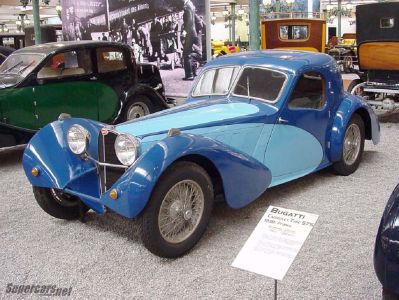
There is no such “confusion” about the second coupe, now in the Schlumf
Collection. Designed by Van den Plas and built by Corsica for C.W.P Hampton,
this is one of only two 3 seater coupes on the T57S; the other one being 57501
by Gangloff. Given the extra space demanded by the third seat, both these cars
turned out very elegant, and 57602 has the most beautifully appointed interior
which, remarkably, is still with the car. Pierre-Yves Laugier convinced the
Schlumf Collection to roll all their T57SC’s out to be photographed for his book
and it is the first time that I’ve had the opportunity to see images of her
bathed in natural light. Like most of the Schlumf Bugattis, it is now finished
in a rather indifferent manner and the removal of the wheel spats make the rear
look strangely bulbous, not helped by the boring colour scheme. It must have
looked stunning in its original two-tone metallic blue with silver-gray leather.
Getting back to 57602, the 42nd and last chassis sold to a client, completed her
final factory road-test on the 19th of May 1938. It was allocated to C.W.P
Hampton on May the 25th and delivered to him Jun the 3rd , then sent to Corsica
who, after six weeks of work, handed it over to its first owner on July the
23Rd, in time to make the start of the Paris-Nice race on the 1st of July 1938.
GPK 1 did not win, but neither was she disgraced by her performance. In 1946
Peter Hampton fitted a supercharger (ex 57804C) and sold her to Matthew Pryor in
1954, who in turn passed it onto John Shakespeare during the early sixties. It
formed part of the collection of Bugattis he sold to the Schlumpf brothers, in
whose collection she has resided ever since.
To conclude on a personal note; I remain intrigued by the management of the
Schlumf collection. The brothers had most of their cars restored, but not well,
and they did the weirdest thing with the prototype Type 28. When acquired,
together with the rest of the factory collection, this was a chassis only, yet
they saw fit to have a body constructed and fitted, making it impossible to see
Ettore’s first straight eight. But the greatest mystery to me is the impression
that relatively few of the citizens of France actually like the Schlumpf
collection. I believe President Mitterand called it “madness.” I could be under
a mistaken impression; perhaps someone can explain to me how this collection
sits with French Bugatti enthusiasts? Surely indifference cannot be the reason?
I am confused – both Versailles and the Louvre are fitting symbols for French
culture and civilisation, but the greatest Bugatti shrine gives the appearance
of neglect. What am I missing here?
Tourer Number One
57503 Engine 16S
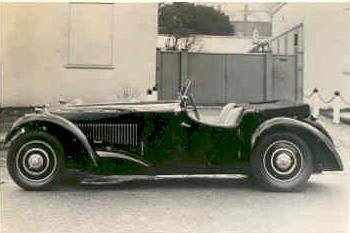
Sir Robert Ropner’s tourer has the most memorable front wings, thin in section,
beautiful in profile and placed high above the wheel with the deftness of a
raised eyebrow. The whole of the front is pared back, revealing just enough to
display the mechanics to perfection. This is English understatement at its best,
and that applies, in fact, to both the tourers. Personally I prefer 57503,
simply because Corsica achieved separate, yet complimentary, identities for each
profile. Usually I am not a great fan of a single side mounted spare-wheel, but
the elegant dressing of the oil tank on the left compliments the low mounted
spare on the right to perfection. I would actually go as far as to say that
57503 has a better resolved look for the oil tank than the Col. Giles car. But
really, there is almost no bad angle to view this car from.
One thing, though; I have never seen a photo of either tourer with the hood in
the raised position. I suspect the rear to be uncomfortably high to give a
modicum of headroom for the rear seat passenger/s. The back seats are by
necessity placed higher than the front seats due to the location of the rear
axle, and I believe leg-room to be similarly compromised. Does it matter? No.
This chassis was delivered to Colonel Sorel, Bugatti’s London agent, on
29/01/1937 and sent to Corsica early in February to receive the second T75S body
(the first was 57375) and the first touring body. The car was registered in the
name of Sir Robert Ropner , County of Durham, with the registration number DUL
351. Which means they took less than a month to construct and finish the
coachwork. Which is quick. Sir Robert owned the car till 1945 when he sold it to
Rodney Clarke who promptly crashed it. How very careless. In 1946 H. H. Coglan
acquired the remains and over the period of a year rebuilt the car before
selling it to the memorably named K.G.A. Cock de Harlow in July 1953. Although
the car seems to have been a little temperamental, he enjoyed it until 1969,
when he sold it to Bill Turnbull who still has it. Nearing the end of a
protracted restoration, Mr Turnbull has discovered a most intriguing anomaly.
Instead of the normal 3.5 mm thickness, the chassis frame, with 16S engraved
front left, is of 4mm thickness. I shall remain none the wiser, but perhaps a
real historian can see to it that I am just a little better informed Any ideas?
From what I can gather, Mr Turnbull seems to have gone to great lengths to
ensure restoration to exact original specification, and I, for one, am looking
forward to seeing DUL 351 being enjoyed by the man who has honoured this
beautiful car with such sincere originality. She is well prepared for
immortality.
Tourer Number Two
57512 Engine 19S
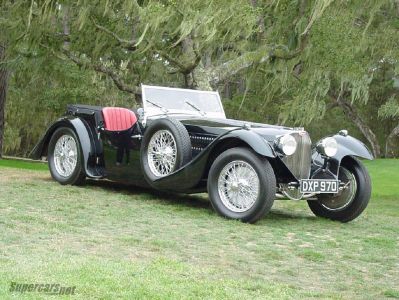
When this second tourer appeared at Pebble Beach in 2003, she was wearing her
original Corsica coachwork, which she regained in 1998, after losing it in 1955
in favour of a low and very light body, constructed and fitted by Hiram Hillegas
of Allentown, Pennsylvania for then owner Walter Stocklin, to enable her to keep
up with much younger competition during the early post-war years of sports car
racing in America. In 1960 John North bought both this car and her original
coachwork, soon sold, before ending up, fitted to a T57S chassis of questionable
parentage, with Count Hubertus von Doornoff. Meanwhile, John North has kept
chassis 57512, fitted with the Hillegas body, until such time that he could
repurchase the original body. The Hillegas body was removed and by 1999, 57512
was resplendent in her original finery. Shortly thereafter, she moved to the
Blackhawk collection where she resided until at least 2004, only the red leather
upholstery and chrome wire wheels keeping her from appearing as originally
intended. Oh, and she’s missing her roof.
Originally owned by Maurice Fox-Pitt Lubbock, delivered to him during March 1937
and registered DXP 970, this car was originally painted black, with black
leather upholstery and body coloured wheel-disks. Comparison with 57503 reveals
the totally separate identities Corsica achieved by differing the treatment of
the wings, for what was, essentially, two very similar looking bodies. The left
front wing hides the oil tank as successfully as 57503 displays it, while on the
right, the single spare wheel nestles into the back of the wing with nearly as
much visual delight as that provided by the suspended item on 57503. DXP 970’s
front end treatment, while elegant, does not display the front suspension nearly
as well as 57503, but this is merely my opinion. By no stretch of the
imagination can she be considered as anything but a master-piece of late 1930’s
automotive haute-couture.
Now if someone could just return her to original appearance, I can devote all my
time to achieving world peace, and a cure for the common cold. But until such a
glorious event takes place, you will simply have to do without.
Roadster Number One
57375 Engine 3S
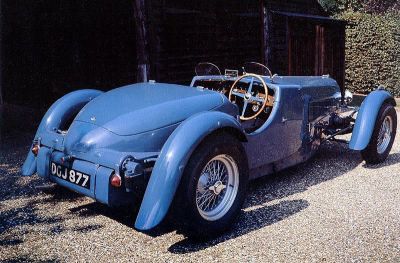
Corsica’s first Type 57S was constructed for Nicholas Embericos and delivered to
him on the 1st of September 1936, registered in his name with registration
number DGJ 877. After an accident during the Tourist Trophy race of 1936, Mr
Embericos, never to race 57375 again, sold her to Mr. Ramponi who then prepared
her for the next years Tourist Trophy. Unfortunately, due to contractual
obligations to the Mercedes Benz race team, Dick Seaman, for whom she was
prepared, never did race 57375. In 1936 Ronnie Symondson bought her and for
forty years ensured that this remained the most raced T57S. He climbed Prescot
nearly 2000 times, which is rather many, don’t you find? Due only to failing
health, he passed her on to Neil Corner, in whose collection she still remain.
Now let me be clear, I am not prepared to state, as fact, that Mr Corner can
walk on water, I merely suspect him of being able to do so. This man was
responsible for collecting and restoring both a 1939 Mercedes Benz Silver Arrow
and a 1938 Auto-Union Grand Prix racer. Both are now sold, but he chose to keep
57375 and today she remains a highly original car, just oozing an authentic
patina of use. Sporting the most deliciously careworn appearance, I suspect this
to be one of the most finely honed performers left. Looking at her engine
compartment, with oil stains and many badges of use displayed so proudly, I am
overcome with a feeling of great humility. A great man, who owns a great car,
enjoys said car for what she can do, not what she looks like. And by doing this
Neil Corner ensures that 57375 remains one of the few T57S’with a continuous
race history. This sorry world of ours is made bearable by men imbued with the
historical sensitivity of the Neil Corner’s of this world. The esteemed Mr.
Corner is not the only one, but he is, however, one of very few. A precious few.
Roadster Number Two
57491 Engine 8S
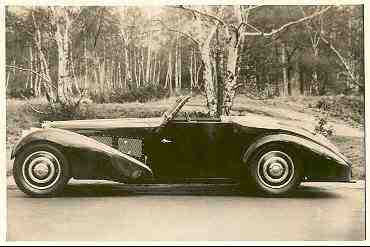
Oh dear. Today she both survives and resides in the collection of Spanish
collector Senor Gonzales, or at least she did when Pierre-Yves Laugier first
picked up a phone to the printers and posed the now immortal question: “Do you
do books?” The last surviving gorgon T57S provides a salutary warning against
cultural cross-pollination. To put it with merciless bluntness: Do not ask
Corsica for a convertible Atalante; you go the Gangloff for that sort of thing,
chassis 57533 jumps to mind. Now that is one elegant automobile; I wish she was
painted her original metallic blue, two tone burgundy is so very Duesenburg,
don’t you think?
T.A.S.O. Mathieson ordered 57491 during November of 1936. Delivered via Col
Sorel to Corsica December 28, 1936, Mathieson received his new car on the 1st of
March 1937. Used initially as a road car in 1938 her coachwork was removed and
replaced with a lighter, cycle winged, racing roadster coachwork. After a
not-terribly-successful period of racing, TASO decided to have the original body
reinstated, and used her as a fast road car until shortly before the outbreak of
hostilities in 1939. It was during this period that TASO tried to buy a T57S
Tank ex-factory. Interestingly enough, Jean Bugatti turned down this order,
sighting the mechanical problems the factory had to deal with following the sale
of four T59’s to British racing drivers.
Following Armistice, TASO soon had 57491 providing singular duty as transport
from one race circuit to the next. More often than not TASO would be accompanied
by the beautiful Mila Parely, the woman he formed a union of love with that
lasted the rest of their lives. When his racing career ended with an accident at
the Caen Grand Prix, Mila immediately gave up her career as successful actress
to nurse her husband back to health. It would be ten long years before TASO
fully recovered, during which time his fortune was squandered by the very people
appointed to guard it. During his later years he devoted himself to the history
of automobile racing and authored several seminal works on the subject.
T.A.S.O. Matthieson may have been unlucky as far as his inherited fortune is
concerned, but having Mila and racing as his two complimentary passions, I do
not believe he ever considered his life as anything but extraordinarily blessed.
Meanwhile, 57491 moved to the collection of Scottish collector, James Farr
during the year 1948. Mr. Farr used her so sparingly that the most of her
recorded mileage of 65000 km. must have been accrued during her tenure with
TASO. Branislav Sudjic (another Scottish collector) bought her in 1975, Andre
Binda had her by 1978, then Nicolas Seydoux in 1985, before being acquired by
Miguel Gonzales in 2000.
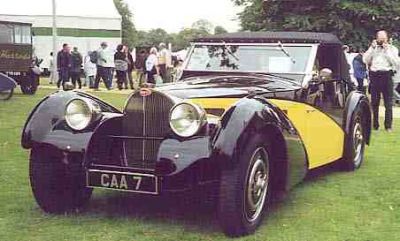
Now painted black with yellow side panels, this car’s proportions still bothers
the heck out of me. The rear, both longer and uglier than an Atalante’s, looks
obese and the window sill line is way too high, pulling the windscreen upwards
with all the subtlety of a reverse bowel movement. As for the front wings, seen
in isolation they are not that bad, they just don’t look like they belong with
rest of the body – that’s all. Let us pray that, not only the present owner, but
all subsequent guardians will think her to be the most beautiful creature on
this earth, otherwise this little mistake may just end up following the fate of
57601 and be torched all the way to Kingdom Come. Oh dear.
Roadster Number Three
57531 Engine 25S

By common consent, Malcolm Campbell’s roadster is considered to be just a touch
more elegant than 57593, and I think that’s about right. Campbell’s car has a
restrained elegance that the louche beauty of 57593 just plain do without.
Complimentary to this, stands, as supreme achievement by the talented craftsmen
of Corsica, the manner of their employing the very continental proportions of
the chassis to so successfully beautify the British ideal of quiet good taste.
The details at the front are deftly resolved, especially at the bottom of the
radiator, and fitted with quite beautiful headlamps, while viewed from behind,
the “English line”, which imbues her with such exquisitely rendered
conservatism, may be clearly observed.
Malcolm Campbell, the first owner, took delivery of DYF 4 on the 22nd of April
1937, only to be returned to Col. Sorel a short time later, then sold as new, to
R.E. Gardner Jr. for the sum of 865 Pounds during February of 1938. Mr. Gardner
had a supercharger fitted and used her sparingly, yet enthusiastically, until
1951, when he decided to freshen her up with a full mechanical renovation. At
the same time, Hauswald, the head mechanic at Bugatti’s Levallois garage before
the war, fitted 57531 with a Cotal preselector gearbox. Mr. Gardner kept her for
nearly forty years, a feat which ensures his place in the pantheon of the gods,
before selling it to the iconic Mr. Neil Corner in 1976. Strangely enough, he
sold her in 1979 to Tom Perkins. Not that Mr. Corner was without a T57S for
long, in 1984 he acquired 57375.
Tom Perkins proved to be as careful a guardian to 57531 as he was to 57591. It
was during his twenty year tenure that she received her second mechanical
refurbishment, carefully performed by Phil Reilly during 1998. Every thing was
rebuilt, with the exception (and what an utterly brilliant exception it was) of
the coachwork. While in the care of Mr. Price, 57531 remained one of only a
handful of untouched original T57S.’ He went on to build one of the greatest
collection of supercharged 1930’s sports cars, as well as writing a book on the
subject, before he disbanded his collection, fearing that it was becoming what
he has long criticized other collections for becoming; under-utilised. In my
humble opinion, the ability to discern between collecting and hoarding is noble
enough justification for the disbanding of such a treasure, but unfortunately it
allowed them to fall into the hands of those whom history will remember for
their avarice, and not for their service to the marque. At any rate, Tom Perkins
did hang on to 57531 for much longer, only selling her to Arturo Keller in
October 2002. She is still painted blue, which means she has not been restored
yet. Burgundy paint, a cream coloured interior and chrome wire wheels will
herald the completion of another merciless Arturo Keller restoration.
While we anxiously awaits her fate of doom, let us enjoy her as she has been for
all her 70 years, blithely untouched by the passing of time. It shall not remain
thus.
Roadster Number Four
57593 Engine 41S
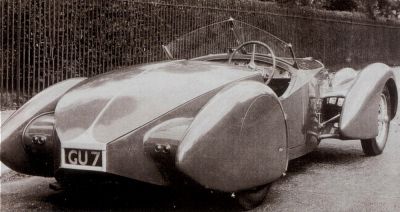
The 1998 Pebble Beach Car of the Show, 57593 is my favorite Corsica 57S, bar
none. Sometimes I think it may just be even more awesome than La Atlantic. Maybe
not the Williams car, but the Lauren one – certainly, especially now. Taken in
isolation, there are some extremely unconvincing features on this car. The front
end is messy, the rear is ghastly and the windscreen is just plain wrong, and
yet, like Sophia Loren, the beauty is beyond compare. The story of 57593 is
inextricably linked to John Mozart and since he restored the car slightly
different to original, I initially allowed my prejudice against Bugatti
collectors to get the better of me. In these days of politically correct
fascism, prejudice is a precious thing that should be flown as proudly as a flag
– a banner of protest against the worship of the lowest common denominator that
have all but destroyed the concept of excellence.
But in a relatively short period of time I have received much information about
Mr. Mozart and a great many, highly respected, Buggattisti holds this man in
very high esteem. Was I wrong about him? Answer – Yes. Very wrong; in fact, he
turns out to be a man greatly aware of the history of his cars. Winning at
Pebble Beach is easy you know, just throw enough money at a coach-built classic
and the thing’s done. However, winning at Pebble Beach without destroying the
soul of the car, is another matter entirely.
While 57593 is less original in its finish than the 2003 winner 57473, it must
be said that if John Mozart restored 57593 as close to original as Dr Williams
did with his Atlantic, then he would have been laughed off the field at Pebble.
It’s a judgment thing innit? And John Mozart has achieved the near impossible;
he has improved a Bugatti without destroying its originality, and how he
achieved this makes for a great story.
Chassis 57593 was originally bought by Col. Giles in 1938. His brother Eric
designed the coachwork and Corsica did the construction. In 1939 57593 passed to
Herman H Harjes who sold it in 1950 to W.A.L. Cook. During the mid 1950’s it
crossed the Atlantic owned by A Erwin Goldschmidt and when he died in 1970 it
went to Richard Paine who sold it to John Mozart in the mid 1980’s. The first
time I became aware of John Mozart’s ownership of 57593 was when Classic and
Sports Car, Nov.1998, p13, wrote about the “dismay” caused by the 1998 Pebble
Beach Car of the Show’s “customized” condition. One of the few truly offensive
articles by C&SC, it dutifully indulged the British Bugatti mafia’s rampant
xenophobia. Allow me to quote from this piece of ill researched garbage entitled
“Tears over crocodile Bugatti”:
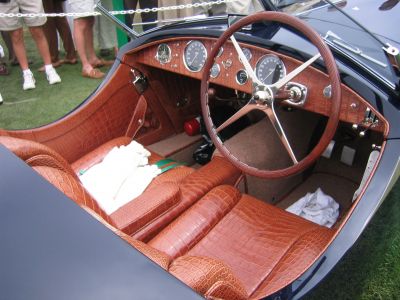
“Dismay has greeted news that a customized Bugatti was the shock ‘best of show’
winner of this year’s prestigious Pebble Beach Concourse d’Elegance, August 16.
The sensational Type 57SC ‘La Petite Suzanne’(sic) was created for Colonel G.M.
Giles by Corsica and the car was debuted by current owner John Mozart in new
sexy black paint (wrong) and bizarre crocodile-skin upholstery and dashboard
finish.” It then goes on to say: ”While the renovated car is certainly
eye-catching, it has met with disapproval from purists: “This is a unique
historic car and any owner should have more sense of history,” said Bugatti
historian David Sewell, “It seems especially unfortunate as this car had led a
particularly sheltered life.(not true) It is a sad fact of life that the
prevalent European trend for old cars to actually look old, doesn’t seem to have
reached California.”(another lie) The pompous Mr. Sewell’s ownership of a
“bitsa” Brescia (with replica body) was, of course, not mentioned. In the
Jan.1999 issue they, to their credit, published letters from both John Mozart
and the late Andy Rheault stating their dissatisfaction in full, but blotted
their copy-book even further by stating that the photograph, printed above the
letters, was taken while in the ownership of Col. Giles, and then to have the
sheer unmitigated gall to pose the question: Does this look like dark blue?. By
the time it acquired that spare wheel cover, clearly visible in said photograph,
Col. Giles no longer owned 57593.
I am a huge fan of Classic & Sports Car and Martin Buckley in particular, but
Simon Taylor allowing his creation to be used by the B.O.C./Bugatti Trust to
propagate their own brand of intolerance, still casts a long dark shadow over
C&SC’s journalistic integrity. Their refusal to own up to this egregious lapse
of judgment is made even more mystifying when seen against their recent
offensively obsequious little hagiography of Ralph Lauren and his Alfa Romeo
8C2.9. M.M Spyder, restored to much better than new condition by the ever
servile Paul Russell.
But I digress. In a desperate, and ultimately futile, bid to restore this great
car’s violated reputation, Mr. Mozart gave it to Winston Goodfellow who then
wrote the best road test of a Bugatti I’ve ever read. I still get enormous
enjoyment from the June 1999 issue of Thoroughbred & Classic Cars. It seemed
that a great many magazines either tested this car, or printed Mr. Goodfellow’s
article. Classic & Sports Car being denied this honour, of course. Nice one Mr.
Mozart! Not that it helped much, to this day it is fashionable to mock the
upholstery of 57593. Let’s take a closer look at this, shall we.
When delivered to Giles in 1938 this car was painted a light blue with brown
‘crocodile leather’ supplied by Connelly. In my opinion this would have been
ordinary leather imprinted with a crocodile texture, a common practice at the
time. Remember what Setright said about the British being oblivious of Art? He
was talking about the Giles brothers. The entire manner of finish of this car
damn nearly ruined it. Dull blue paint, fake crocodile upholstery and the wheels
painted that boring shade of silver often mistakenly viewed as tasteful, the
effect, like the build quality, was nothing short of horrible. Looking at
photographs of 57593 taken upon completion, several clumsy details reveal
themselves, none more so than that hideous piece of black rubber attached to the
front of the rear wings and framed by overly thick beading. The rear wheel spats
are ill-fitting and the boot (trunk) shut line is on the edge of the body
running from the back of the cockpit down to the rear number plate assembly.
This makes for an extremely large, ill-fitting boot lid that looks as if it’s
not closed properly.
Moving to the front of the car one can amuse oneself for hours trying to figure
out which one of the headlights are actually pointing in the right direction. In
front of the radiator there is a panel which look like a feeding trough for
pigs, and the front indicators are too big. The split windscreen is too high in
the middle and too low on the sides, but at least the silver spear running from
it to the radiator is rather well executed.
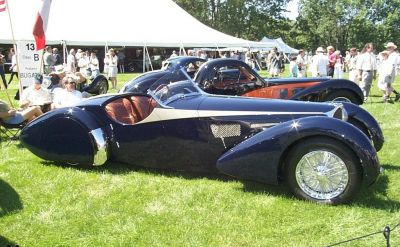
Now lets look at the car as it appears now. The chrome panels attached to the
front of each of the rear wings links beautifully with the silver spear and the
chrome wire wheels is a huge improvement on the original. The headlights are now
both pointing in the same direction and the dark blue paint neatens up the messy
front no end. Looking closely at the two winglets carrying the headlights one
can still see the slight differences in shape as per original and those overly
large indicators are also still there. This car may have been restored but its
soul has been left intact. The dark paint also helps to hide that clumsy shut
line around the boot and while it fits better now than it did originally, it
still reveals its hand built origins. Would that the same could be said for EXK
6.
That interior: Let me ask you a question – Say you have a one-off Bugatti, worth
millions, and you wish to win Pebble Beach for the second time; would you
upholster it in mock crocodile as per original? Yep, didn’t think so. The new
interior has been beautifully executed, and as for the crocodiles who so
gallantly sacrificed their lives; As a citizen of South Africa I happen to
feature on the menu of our overly large crocodile population, right under the
course commonly referred to as ‘small rural child’. Bastards. And not many
crocodiles ever make it to Pebble Beach, do they? It was a good death, you hear
me, a good death. Again I digress, squeal about originality all you like, but
the execution of the new interior is ravishing. “Nothing is too beautiful.
Nothing is too expensive.” So sayeth Ettore Bugatti.
By the way, have you noticed that those who bemoan the fate of cars being
“sacrificed” for Pebble Beach are all enthusiasts of historic racing? Crash a
priceless Bugatti during a prestigious historic race meet, and the press calls
you a hero for “using it as it was originally intended.” Exhibit it at Pebble
and suddenly you are “destroying a precious original” Ah yes, there will always
be a Bugatti Owners Club. Congratulations Mr. Mozart, GU 7’s true beauty was
only revealed once you finished her in a manner befitting her lines, and she
still has soul, still has her provenance and her dignity intact. A truly
remarkable achievement.
I am so done.
FIN
Johan Buchner
28 January 2008
Port Elizabeth
South Africa
Discuss
this article on the forum